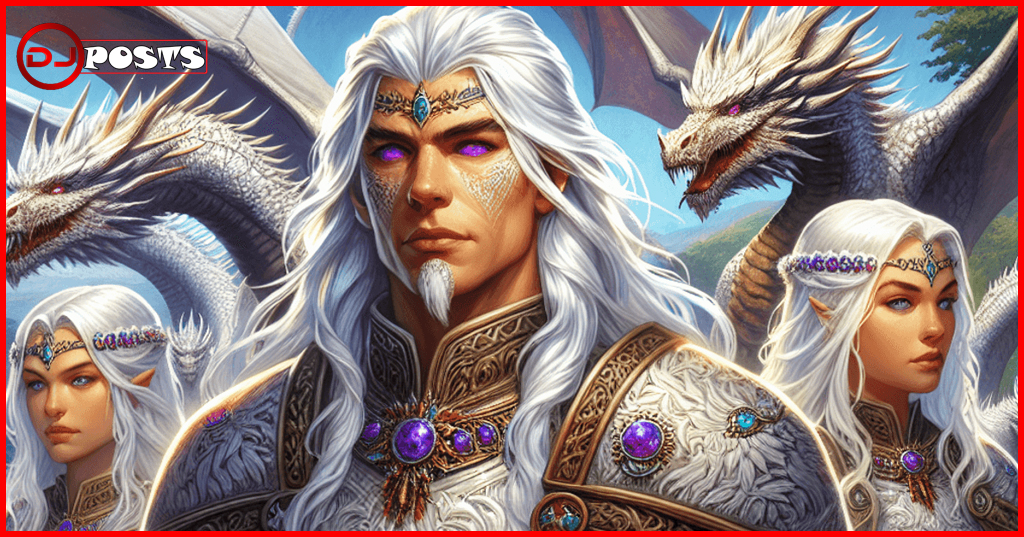House Targaryen is one of the most fascinating and influential dynasties in Westeros history. With their striking silver-white hair, violet eyes, and command over dragons, the Targaryens shaped the Seven Kingdoms for centuries.
The Targaryen family tree tells a story of:
- Power – Their 300-year reign unified previously separate kingdoms
- Dragons – The only house to master these legendary creatures
- Blood purity – Their practice of intermarriage to maintain their unique traits
- Political intrigue – Complex succession disputes that changed the realm
Understanding the Targaryen lineage reveals the intricate web of relationships, alliances, and conflicts that defined Westeros. From Aegon the Conqueror’s initial unification to Daenerys’s quest to reclaim her birthright, each branch of the family tree holds stories of triumph and tragedy.
This guide explores the key figures and events that shaped this remarkable dynasty, offering insights into how their choices continue to influence the world of ice and fire.

Origins of the Targaryens
House Targaryen originated from the ancient civilization of Valyria, a powerful empire known for its mastery of dragon magic and advanced technology. As one of the forty families who ruled over dragons, the Targaryens resided in the Valyrian peninsula, enjoying great influence and authority through their ability to command these legendary creatures.
The Prophetic Dreams and Relocation
When Daenys Targaryen had prophetic visions foretelling the destruction of Valyria, her father Aenar made a courageous choice. He decided to move his family and their five dragons to Dragonstone, an isolated island situated off the coast of Westeros. This decision spared House Targaryen from the devastating Doom of Valyria that annihilated their homeland.
Building Strength on Dragonstone
For almost a hundred years, the Targaryens stayed on Dragonstone, fortifying their power. Everything changed when Aegon I Targaryen initiated his ambitious campaign to conquer Westeros alongside his sister-wives, Visenya and Rhaenys, riding on their dragons:
- Balerion – Aegon’s black dragon, infamous as the Black Dread
- Vhagar – Visenya’s mount, a fearsome beast second only to Balerion
- Meraxes – Rhaenys’ dragon, pivotal in numerous crucial battles
The Unstoppable Force of Dragons
The dragons proved invincible in battle. Their fiery breath melted castle walls and devastated armies, allowing Aegon to bring six out of the Seven Kingdoms under Targaryen rule. The Field of Fire serves as a testament to their might, where three dragons incinerated 4,000 men alive, including King Mern of the Reach.
Key Figures in the Targaryen Lineage
The Targaryen dynasty’s power rests on the shoulders of remarkable rulers who shaped the Seven Kingdoms through their distinct leadership styles and personal choices. These key figures left an indelible mark on Westeros, establishing traditions and making decisions that would echo through generations.
1. Aegon I Targaryen (Aegon the Conqueror)
Aegon I Targaryen stands as the cornerstone of the Targaryen dynasty in Westeros. His reign marked the beginning of a new era, uniting the Seven Kingdoms under a single crown through strategic conquest and diplomatic alliances.
Early Life and Rise to Power
Born on Dragonstone, Aegon demonstrated exceptional military prowess and political acumen. His most significant achievements include:
- Creating the Iron Throne from the swords of conquered enemies
- Establishing King’s Landing as the capital city
- Implementing a unified system of laws across the realm
- Forging the role of Hand of the King
Military Strategies and Innovations
Aegon’s military success stemmed from his masterful use of dragons in warfare. With his sisters-wives Visenya and Rhaenys by his side, he introduced dragons as weapons of mass destruction. His dragon, Balerion the Black Dread, became a symbol of Targaryen might, capable of melting castle walls and decimating armies.
Impact on Westeros
His reign brought significant changes to Westeros:
- Political Structure: Created a centralized government system
- Military Innovation: Revolutionized warfare through aerial combat
- Cultural Impact: Introduced Valyrian customs and traditions
- Religious Policy: Maintained diplomatic relations with the Faith of the Seven
Leadership Style
Aegon’s leadership style balanced strength with wisdom. He allowed conquered kingdoms to maintain their customs and retain their lords, provided they swore fealty to the Iron Throne. This strategic approach helped stabilize his rule and established a dynasty that would last for centuries.
2. Aenys I Targaryen
Aenys I Targaryen’s ascension to the Iron Throne marked a stark departure from his father’s legendary reign. As Aegon the Conqueror‘s firstborn son, he inherited a unified realm but lacked the commanding presence that had defined his predecessor.
His rule faced immediate challenges:
- Religious uprisings led by the Faith Militant
- Multiple rebellions across the Seven Kingdoms
- Questions about his legitimacy as heir
Unlike his father’s decisive leadership, Aenys proved indecisive in crisis moments. His gentle nature – while admirable in peacetime – proved ill-suited for maintaining the iron grip his father had established. Where Aegon I commanded respect through strength and dragons, Aenys struggled to assert authority through diplomatic means.
The stark contrast between father and son became evident in their handling of rebellions. Aegon would mount Balerion the Black Dread to crush opposition. Aenys, by comparison, often sought compromise – a strategy that emboldened his enemies and weakened the crown’s authority.
These mounting pressures eventually forced Aenys to flee to Dragonstone, where stress and anxiety led to his deteriorating health. His death paved the way for his half-brother Maegor’s brutal reign.
3. Maegor I Targaryen (Maegor the Cruel)
Maegor I, the third Targaryen king, earned his infamous nickname through a reign of unprecedented brutality. The son of Aegon the Conqueror ascended to the throne by usurping his nephew’s claim, setting a dark precedent for future succession crises.
His six-year rule was marked by savage responses to opposition. He executed builders of the Red Keep to protect its secrets, burned septons alive, and waged a merciless campaign against the Faith Militant. His brutality extended to his personal life – he took multiple wives, forcing them to compete for producing an heir. Those who failed faced death.
Under his command, the construction of the Red Keep was completed, including the dreaded dungeons. His most lasting legacy remains Maegor’s Holdfast, a fortress within the Red Keep named for its imposing defenses.
His death in 48 AC, found impaled on the Iron Throne, sparked rumors of suicide or murder. The bloodshed during his reign weakened House Targaryen’s grip on power and created deep rifts between the crown and the Faith that would persist for generations.
4. Jaehaerys I Targaryen (Old King)
Jaehaerys I brought unprecedented peace and prosperity to the Seven Kingdoms, earning him the title “The Old King” during his 55-year reign – the longest of any Targaryen monarch. His rule marked a stark contrast to Maegor’s bloody legacy.
The king’s marriage to his sister Alysanne proved instrumental in shaping Westeros. Together, they implemented sweeping reforms:
- Creation of the King’s Road network connecting major cities
- Establishment of a unified legal code across the realm
- Reform of the Night’s Watch
- Abolition of the “First Night” tradition
Queen Alysanne’s influence extended beyond traditional royal duties. She championed women’s rights and convinced Jaehaerys to outlaw several antiquated practices. Their partnership demonstrated how Targaryen marriages could strengthen rather than weaken the realm.
Their reign saw thirteen children born, though tragedy struck as many died young. Despite personal losses, Jaehaerys maintained stability through diplomatic solutions rather than force, earning loyalty through wisdom rather than fear.
The Old King’s legacy lived on through the institutions and infrastructure he built, creating the foundation for the Targaryen dynasty’s golden age.
5. Viserys I Targaryen
Viserys I’s reign marked a golden age of peace and prosperity for the Seven Kingdoms. As grandson to the beloved Old King, he inherited a stable realm and maintained harmonious relations with noble houses through diplomatic marriages and alliances.
His decision to name his daughter Rhaenyra as heir sparked controversy among traditionalists who favored male succession. Despite this, Viserys stood firm in his choice, having his lords swear fealty to Rhaenyra as his successor.
The king’s second marriage to Alicent Hightower created deep rifts within the royal court. Their children’s competing claims to the Iron Throne divided the family into two factions:
- The Blacks – supporters of Princess Rhaenyra
- The Greens – allies of Queen Alicent and her son Aegon
These tensions simmered throughout Viserys’s later years. His death in 129 AC ignited the powder keg of rivalry between his children, plunging the realm into the devastating civil war known as the Dance of Dragons.

The Dance of Dragons: Civil War Among Targaryens
The Dance of Dragons was the bloodiest chapter in House Targaryen’s history. Princess Rhaenyra, King Viserys I’s firstborn child, was his chosen heir. Throughout her youth, she was proclaimed as the successor, with lords across the Seven Kingdoms pledging loyalty to her future reign.
The Cause of Conflict
Conflict arose when Queen Alicent gave birth to Viserys’s son, Aegon II. After Viserys’s death, Alicent and her supporters secretly crowned Aegon II, going against the late king’s wishes. This act divided the realm into two factions: the blacks (supporters of Rhaenyra) and the greens (supporters of Aegon II).
Key Players in the War
Prince Daemon Targaryen, Rhaenyra’s uncle-husband and skilled warrior, became her strongest ally. His military skills and control over the dragon Caraxes bolstered her position.
Major Battles of the War
The war witnessed unprecedented battles between dragons, including legendary confrontations at:
- Rook’s Rest
- The Gullet
- Gods Eye
Turning Points in the War
Aegon II’s forces captured King’s Landing, forcing Rhaenyra to escape. Her short reign as queen ended tragically when Aegon II fed her to his dragon, Sunfyre, while her son looked on. This brutal act symbolized the brutality of Targaryen fighting Targaryen, dragon against dragon, in a conflict that nearly obliterated their dynasty.
Aftermath of Civil War
The devastating Dance of Dragons reshaped House Targaryen’s future through its youngest survivors. Aegon III, Rhaenyra’s eldest surviving son, ascended to the Iron Throne at the tender age of 11. His reign earned him the name “Dragonbane” – a bitter reminder of the last dragon’s death during his rule. The trauma of watching his mother’s death leave deep psychological scars, resulting in a melancholic personality that defined his 26-year reign.
His younger brother, Viserys II, faced a different path. Captured during the war and presumed dead, he spent years in exile across the Narrow Sea. His eventual return brought valuable diplomatic skills to the Seven Kingdoms. As Hand of the King to three different monarchs, Viserys II’s administrative abilities helped stabilize the realm.
The civil war’s impact on House Targaryen proved permanent:
- Significant reduction in Targaryen numbers
- Loss of most dragons – their primary source of power
- Weakened political influence across Westeros
- Divided loyalties among noble houses
- Shift in succession laws favoring male heirs
These changes marked the beginning of House Targaryen’s gradual decline. The once-mighty dynasty’s power diminished, setting the stage for future challenges to their rule. The scars of brother fighting sister, dragon against dragon, as seen in the brutal conflict between Rhaenyra I and Aegon II, would haunt the family’s legacy for generations.
Later Generations and Their Legacy
The Targaryen dynasty’s later chapters unfold through two pivotal figures: Rhaegar Targaryen and his sister Daenerys. Rhaegar, the crown prince, sparked a chain of events that would reshape Westeros. His secret marriage to Lyanna Stark ignited Robert’s Rebellion, shattering the centuries-old Targaryen rule. This fateful romance led to:
- The fall of King’s Landing
- The death of the Mad King Aerys
- The near-extinction of House Targaryen
Daenerys Targaryen emerged as the last surviving member of her house, forced into exile as an infant. Her journey from a powerless exile to a formidable leader mirrors the rise of her ancestor, Aegon the Conqueror. Through sheer determination, she:
- Hatched three dragons – the first seen in over a century
- Built an army of Unsullied warriors
- United the Dothraki hordes
- Liberated slave cities across Essos
The birth of Daenerys’ dragons marked a renaissance of Targaryen power, echoing the magical bond between the dragonlords and their scaled companions. Her quest to reclaim the Iron Throne carried the weight of her family’s legacy – a testament to the resilience of Targaryen blood.
The later Targaryens’ story demonstrates how personal choices can alter the course of history, whether through Rhaegar’s pursuit of love or Daenerys’ mission to restore her family’s glory.
Themes in the Targaryen History
The Targaryen dynasty embodies recurring patterns that shaped their 300-year rule in Westeros. At its core, House Targaryen’s story revolves around the eternal struggle for power – not just against external threats, but within their own bloodline.
Power Dynamics & Succession
- Siblings turning against siblings
- Parents pitting children against each other
- Claims to the throne sparking devastating wars
- Dragon possession as a symbol of authority
The Targaryen practice of intermarriage created a double-edged sword for their dynasty. While meant to preserve their unique Valyrian traits – silver hair, purple eyes, and dragon-riding abilities – this tradition had profound consequences:
Impact of Intermarriage
- Enhanced magical connection to dragons
- Preservation of physical Valyrian features
- Mental instability in some family members
- Birth complications and reduced fertility
- Heightened family tensions and rivalries
The infamous saying “Every time a Targaryen is born, the gods toss a coin” emerged from these practices. This genetic roulette produced both legendary rulers like Jaehaerys I and tyrannical figures like Maegor the Cruel. Their obsession with bloodline purity ultimately contributed to their downfall, as successive generations became increasingly susceptible to madness and internal conflict.
The power dynamics within House Targaryen mirror a larger truth about ruling dynasties – the greatest threats often come from within. Their story demonstrates how the pursuit of power and genetic purity can lead to both greatness and destruction.
Conclusion
The Targaryen family tree is a testament to one of the most fascinating dynasties in fictional history. Their saga teaches us valuable lessons about power, family bonds, and the price of ambition.
Want to dive deeper into the world of dragons and dynasty? Here are some recommended resources:
- Fire & Blood by George R.R. Martin – A detailed chronicle of the Targaryen reign
- HBO’s House of the Dragon series – A visual exploration of key historical events
- The World of Ice and Fire companion book – Rich illustrations and extended family histories
The Targaryen legacy continues to captivate readers and viewers, proving that their story – filled with triumph, tragedy, and dragons – remains an enduring part of Westeros lore. Their complex family tree reveals not just a lineage, but a tapestry of human nature itself.
FAQs (Frequently Asked Questions)
What is the significance of the Targaryen family tree in Westeros history?
Understanding the Targaryen family tree helps us comprehend the complexities of their dynasty and their impact on the history of Westeros.
Who was Aegon I Targaryen and what were his major achievements?
Aegon I Targaryen, also known as Aegon the Conqueror, was the first king of the Targaryen dynasty. His major achievements include the conquest and unification of Westeros, as well as the introduction of dragons into warfare.
What challenges did Aenys I Targaryen face during his reign?
Aenys I faced significant challenges during his rule, including civil unrest and difficulties stemming from his father’s legacy. His reign was marked by struggles to maintain stability in a kingdom that was still adjusting to Targaryen rule.
How did Maegor I Targaryen earn the title ‘Maegor the Cruel’?
Maegor I earned the title ‘Maegor the Cruel’ due to his tyrannical rule characterized by extreme measures against his subjects and rivals. His reign was marked by violence and civil unrest, which left a lasting impact on House Targaryen.
What was the Dance of Dragons and its significance?
The Dance of Dragons was a brutal civil war among Targaryens, primarily centered around Rhaenyra Targaryen’s claim to the throne against her half-brother Aegon II. This conflict had significant consequences for House Targaryen, leading to substantial losses and changes in power dynamics within the family.
How did Daenerys Targaryen relate to her family’s legacy?
Daenerys’ journey from exile to claiming her family’s legacy involved reclaiming her identity as a Targaryen. Her connection to dragons symbolizes her attempt to restore House Targaryen’s former glory while navigating complex historical themes such as familial conflict and power struggles.



[…] The Targaryen Family Tree: A Comprehensive Guide […]